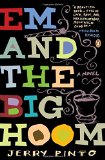Summary | Excerpt | Reviews | Beyond the Book | Read-Alikes | Genres & Themes | Author Bio

 Book Reviewed by:
Book Reviewed by:
Kim Kovacs
Buy This Book
This article relates to Em and the Big Hoom
In Em and the Big Hoom, Imelda Mendes ("Em") suffers from bipolar disorder, a condition formerly known as "manic depression" that about 2.4% of people around the world
have been diagnosed with at some point in their lifetime.
Bipolar disorder manifests itself as extreme highs and lows in mood, with these swings being far more severe than people ordinarily experience. In the manic phase people may appear overly joyful, excited or agitated, and may exhibit erratic or irresponsible behavior. They may also suffer from delusions, such as believing they're excessively wealthy or have special powers. After a period of time — which could be a few hours, days or weeks — the individual will then move into a depressive phase, where they become unable to function, extremely sad and hopeless and disinterested in things they formerly enjoyed. The condition is recurrent; 90% of those who have a single episode with have others over time.
Generally patients fluctuate between these two states, often with periods of normalcy between cycles which shortens over time (on average a person is free from symptoms for five years between their first and second episodes, with the respite lessening with each successive bout). A person can, however, be in a "mixed state," in which both mania and depression are present at the same time or the fluctuation between the two states is very rapid.
People can also exhibit an emotional state referred to as hypomania, a manic stage in which they feel very good, productive and high-functioning; in this phase the person generally doesn't realize they have a problem, and the fact that they aren't acting normally is only apparent to family members and close friends.
There are several types of bipolar disorder:
Causes for bipolar disorder are unclear; the speculation is that complex genetic, neurochemical and environmental factors intersect at many levels to cause the condition to manifest itself. It is known, however, that people with a bipolar family member are more likely to develop it. Symptoms most frequently appear in an individual's late teens or early 20s.
Bipolar disorder generally persists throughout a person's life and long-term treatment is needed. Medications such as mood stabilizers, anti-convulsants, anti-psychotics and antidepressants are prescribed; most people are on some combination, with the drugs and doses changing — sometimes on a daily basis — depending on the phase they're currently exhibiting. The pharmaceuticals are usually used in conjunction with psychotherapy which can help provide support, education and guidance to the patient as well as to his or her family. Electro-convulsive therapy (ECT), formerly known as "shock therapy," may also be used; while the technique has a bad reputation, there have been huge improvements over the past few years and it has been shown to provide relief for some who haven't responded to other treatments.
There is no physical or psychological test that can predict who will develop bipolar disorder or is currently afflicted. A thorough examination can rule out other potential causes — such as a stroke, brain tumor or thyroid condition — of a behavior change. Once these conditions are ruled out, bipolar disorder can still be difficult to diagnose. It may be seen as simple deep depression, or because of associated delusions can be misdiagnosed as schizophrenia. The key, however, seems to be early detection and treatment; those who begin therapy before their mid-20s seem better able to adapt their lives to the condition.
Filed under Medicine, Science and Tech
![]() This article relates to Em and the Big Hoom.
It first ran in the September 3, 2014
issue of BookBrowse Recommends.
This article relates to Em and the Big Hoom.
It first ran in the September 3, 2014
issue of BookBrowse Recommends.




Your guide toexceptional books
BookBrowse seeks out and recommends the best in contemporary fiction and nonfiction—books that not only engage and entertain but also deepen our understanding of ourselves and the world around us.